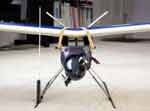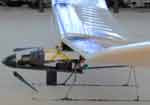My first design. Based around a scratch-n-dent Great Planes Spectra 2-meter wing.
V-tail inspired by
Stefan Vorkoetter.
The open frame holds large payloads near its CG, with good visibility
for sensors and antennas.
Built and flown 1/2004 - 5/2004.
Why "helicopter" skids? Because ground handling isn't needed, but the guts do need protection.
This saves 5 oz over similar-capacity aluminum or carbon landing gear (never mind wheels).
Dimensions:
2 m span. 1040 mm long. 1034 g (36 oz) and 7.7 oz/sqft dry. Payload about 450 g.
Excluding the wing, this is half the weight of a
stock Spectra.
Tail moment is about 50% more too: 635 mm TE-to-TE.
Stall estimate of 3.7x sqrt(wing loading (oz/sqft)) = 10 mph with max payload.
Power:
2s2p 3270mAh Kokam LiPo battery
Plettenberg Freestyle-L brushless direct-drive
Aeronaut 9.5x5 folding prop, −2.5° hub making it about 9.5x3.8.
Thrust-to-weight ratio 45% dry, 33% loaded.
Full throttle: 86% efficient, 19 oz thrust, 9.5 A, 7000 RPM, 41 minutes, 32 mph prop speed.
Either full throttle climb or glide, nothing in between: efficiency drops greatly.
Control:
Deans base-loaded antenna
FMA Quantum 8 rx
Two Cirrus CS-5.4 servos and Dubro ball links for V-tail.
Shims above the wing saddle adjust wing incidence.
Materials:
Carbon cloth, tow, tubes; aluminum sleeves (drilled-out circuit board standoffs);
music wire; aramid cloth and thread; various foams and epoxies;
CA, aliphatic, Shoe Goo, 2-sided tape; Teflon tubing;
Oracover Lite and custom shiny film from
Air Dynamics (aka NY Blimp, aka Gabriel Baltaian).
Other bits of balsa and aluminum. And even some oak if you look closely!
Lessons learned:
• JB-Weld, though easily sanded, is weaker than unadulterated epoxy.
Many of epoxy's properties can be improved with additives, but strength isn't one of them.
• Aramid thread (technically, yarn) isn't unobtanium.
As rigging wire it snaps under shock loads.
Stronger: multiple yarns braided or twisted together, wetted out and then some
with epoxy. Or ice-fishing line. (But this thread excels at lashing.)
• On even slightly long grass, the skids dig in: the curved tips do nothing.
• Skids this tall encourage nose-over landings because the CG is high.
• One large-radius tube is stiffer and stronger than two thinner tubes.
|
![]() Tubular
Tubular
![]() Page 1 | Construction
Page 1 | Construction



